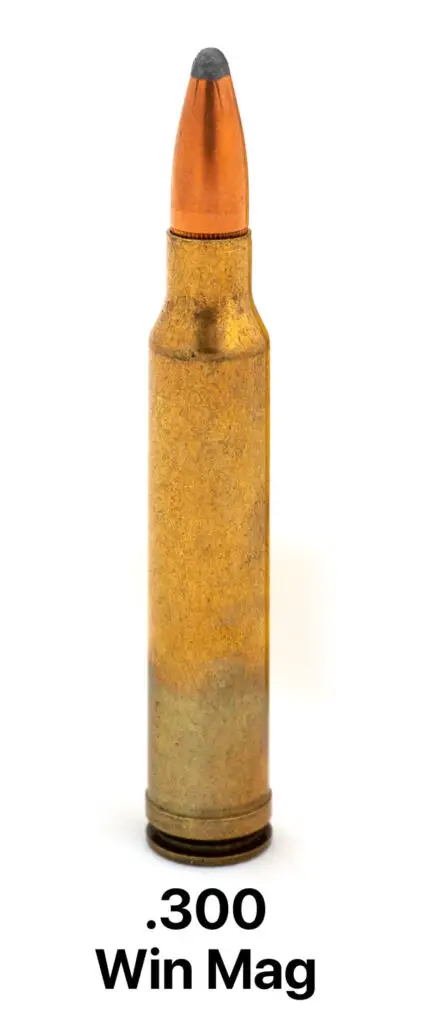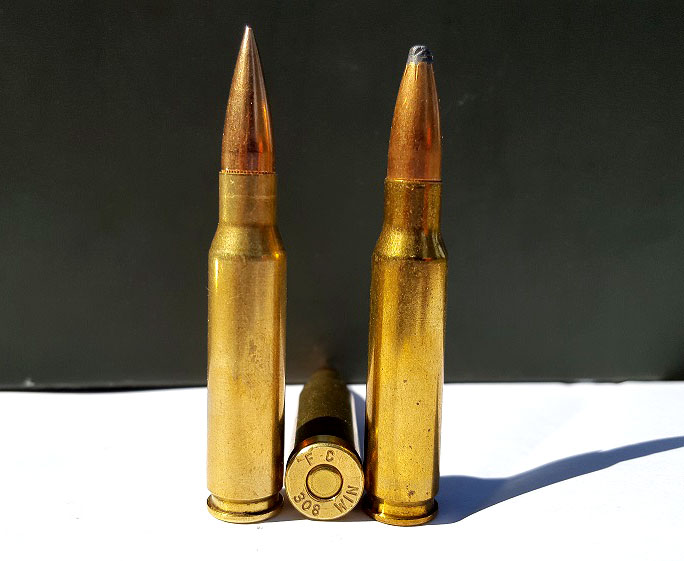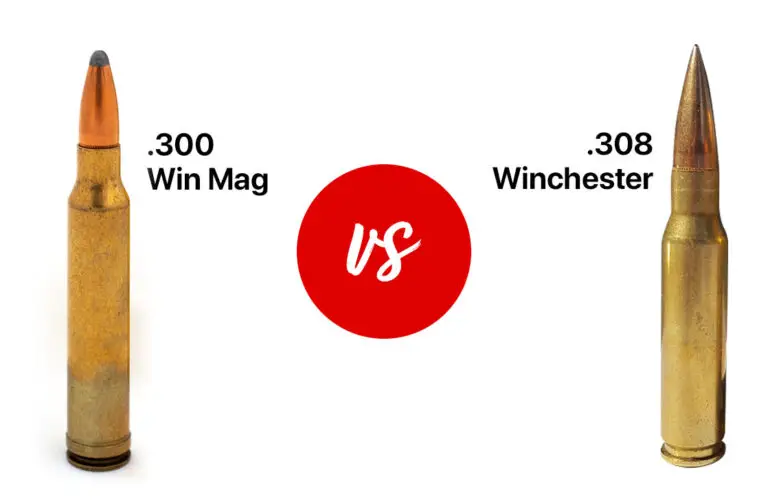Among modern rifle calibers that are more than capable of long-range target and hunting performance, two of the more popular choices among American shooters are the .308 Winchester and the .300 Winchester Magnum (shortened to .300 Win Mag). In this piece, the two cartridges are compared head to head so that you can choose the one that will give you the results you’re looking for, whether on the range or in the field.
The piece begins with a brief history of each cartridge: in this case, the two are deeply intertwined with one another. From there, each cartridge’s ballistic performance is outlined before a final analysis of practical shooting is presented to help you decide which one of these two Cold War-era cartridges is right for you.
Both the .308 and .300 Win Mag are capable, long-range cartridges. The former is cheaper and more available in terms of both the variety of rifles chambered and finding ammo. The latter, on the other hand, is slightly more accurate and powerful. Both can be great choices for a variety of shooters, but the application will ultimately determine your choice.
| .300 Win Mag | .308 Winchester | |
| Designed | 1963 | 1952 |
| Diameter (bullet) | .308 in | .308 in |
| Length (overall) | 3.34 in | 2.800 in |
| Max Pressure | 64,000 psi | 62,000 psi |
| Case Type | Belted, bottleneck | Rimless, bottleneck |
Historical Evolution
History of. 308 Winchester

The World Wars were arguably the largest testing ground thus far in human history for the development of weapons and, particularly, for small arms. The First World War demonstrated to most countries involved that the bolt-action rifles that had developed by the end of the 19th century were more than accurate enough for warfare, powerful enough to have a devastating effect on the enemy, but far too slow to operate for the up-close combat found in the trenches.
Similar lessons were found in the Second World War, but with an addition: the pistol-caliber cartridges fired by submachine guns worked fine in close, urban settings, but did not pack enough performance for the moderate ranges found in that war’s more mobile combat. Additionally, fighting with several allied nations side by side, all of them using their own cartridges, made logistics unnecessarily challenging in an already difficult environment.
To meet the problem of both pistols and cartridges in the middle, and to solve logistics problems for the newly-formed NATO alliance just after World War II, a new cartridge was proposed in the early 1950s- the T65. This cartridge was slightly smaller than the .30-06 used in the M1 Garand, larger than the .30 Carbine shot from the M1 Carbine, and fed reliably in semi-automatic actions. It had more than enough power for most combat situations and, with more than a little bureaucratic and political wrangling (and, importantly, several design changes), was adopted as the 7.62mm NATO in 1954.
During the period in which the T65 cartridge was introduced to NATO trials, Winchester saw an opportunity for an emerging market: this new cartridge was a little softer shooting than the older .30-06, was highly accurate, and fed well in a variety of action types, including both semi-automatic battle rifles and in bolt actions. Winchester used early versions of the T65 design to develop the .308 Winchester that we see today. The eventual NATO round was marginally larger, but the dimensions are so close that 7.62 NATO can be reliably fed into .308-chambered rifles (but not the other way around, as the .308’s case is a little thinner and might rupture).
It turns out that a cartridge purpose-designed for use against mammals that are between 100-300 pounds at ranges out to 500 yards has great applications for both military and civilian use: this is one of the many cases where developments in the military sphere spill over into civilian life. Both the 7.62NATO and the .308 Winchester can be considered offshoots of the T65, and both are still popular today because they are effective, accurate, and reliable cartridges that take advantage of many lessons learned in the 20th century.
History of .300 Winchester Magnum

With any successful hunting cartridge in the US, there is a high chance that someone will develop a magnum version that adds more powder, and often heavier bullets, in an attempt to make a cartridge that is capable of taking bigger game animals down, shooting at longer ranges or both. That’s exactly what happened with the .300 Winchester Magnum.
First introduced in the early 1960s, the .300 Winchester Magnum took the already popular .338 Winchester Magnum case and married it with .30 caliber bullets. This sizing down of bullets allows for more velocity with the same amount of burnt powder. Even better, those .30 caliber bullets are the same diameter as those used in the .308. This allows hunters and target shooters to have access to the wide array of bullets available for the .308 and 7.62mm NATO.
In terms of the success of a particular product, it often makes sense to make use of some widely-held standard, and this is especially true in the firearms realm. After all, if NATO and the US are willing to invest in retooling their arsenals with .308 bullets, those will likely be around for some time, and the sheer volume of bullets produced will keep costs down for the customer. The .300 Winchester Magnum’s predecessor, the .338 Winchester Magnum, is an awesome cartridge that is more than capable of hunting or target shooting: the .300 Win Mag can be seen as an update to it that sizes down the bullet in order to get more velocity and to share a commonality of bullets with some of the most-produced cartridges in the Western World.
Historically, the .300 Win Mag can be seen as having two parents: the .338 Winchester Magnum brought the larger case size, and the .308 Winchester brought the bullet. Put together, the .300 Winchester Magnum can be considered something of a supercharged version of the .308 for those looking for a little more punch at extended ranges.
Ballistic Performance
Internal Ballistics: Powerhouse Vs. Efficiency
- Common bullet weights for the .308 Winchester range from 125 to 175 grains: out of a 24-inch barrel, this results in velocities between 2500-3100 feet per second.
- Typically, rounds from a .308 leave the barrel in the neighborhood of 2550-3111 ft-lbs of energy. This makes it a consistent and efficient cartridge.
- .300 Winchester Magnum loads tend to use heavier bullets, in the 150-220 grain range, and put them downrange at 2875-3300 feet per second.
- .300 rounds leave the barrel at 3828-4038 ft-lbs of energy. The .300 Winchester Magnum bullet flies a little faster and hits a little harder than the .308 Winchester
Winner: .300 Winchester Magnum
External Ballistics: Trajectory and Distance
- .308 is flat shooting, out to about 200 yards. At that point, the round drops off steadily until around the 700-yard mark, where the drop becomes more pronounced. This makes it a workhorse cartridge in target shooting and hunting applications.
- The .308’s consistent speed across bullet weights makes it a good round to train with depending on the pairing, cheaper training ammo might not fly that differently from match-grad target or hunting ammo.
- .300 Winchester Magnum is very flat shooting out to 400 yards: this gives it more reach than the .308 Winchester.
- .300 Win Mag drops more gradually, too: this makes longer distances possible, but the wide range in muzzle velocities between bullet weights means that you’ll want to stick with one specific loading to make the rifle shoot consistently.
Winner: .300 Winchester Magnum
Terminal Ballistics: Stopping Power
- .308 is no slouch when it comes to stopping a target: there’s a good reason that NATO forces are going back to 7.62mm with the SCAR and similar platforms after decades of using 5.56mm.
- While it hits hard, at ranges over 500 yards, .308 might be best used for suppressive fire. After all, it shares a lineage with a cartridge meant for use in machine guns such as the M60.
- The heavier bullet weight gives the nod to the .300 Winchester Magnum in terms of stopping power at equivalent ranges: heavy bullets hit hard, and the heavier it is, the more inertia it transfers into the target upon impact. The heavier bullet weights common to .300 Win Mag cartridges give it the edge here: that’s exactly why the Navy SEALS developed and used the Mk. 13 sniper rifle in this caliber.
- The flatter trajectory found in .300 Win Mag likely also translates to a higher hit probability at extended ranges, and hitting the target is the most important part of the stopping power discussion.
Winner: .300 Winchester Magnum
Rifle Platforms and Ammunition
Rifle Requirements: Action and Barrel
- .308 is one of the more widely adopted cartridges on Earth. The Springfield M1a is chambered for it, as are most AR 10s. Additionally, short and long-action bolt guns from a wide variety of manufacturers can be found.
- Because of the popularity of the cartridge, you’ll likely be able to find a rifle that is within your budget, and that shoots well! Even a sub $500 bolt action can shoot with 1 MOA accuracy if the shooter does their bit.
- The .300 Winchester Magnum is a little hotter than the .308 and thus requires longer and beefier actions: expect to find more expensive bolt-actions in this caliber.
- .300 Win Mag’s legacy as a specialist hunting cartridge means that the guns chambered in it tend to be both precise and on the expensive side.
Winner: .308
Ammunition Availability and Cost

- Neither of these cartridges is cheap to shoot.
- .308 is typically about double the price of 5.56mm but can be found online widely. Things like wars, sanctions, and other crises often make ammo prices go up.
- .300 Winchester Magnum varies a lot in cost: some of the cheaper loadings can be found on sale for the same price as comparable .308, but match-grade loadings can be double the price of 308. Frankly, both the .300 Win Mag and the .308 are going to need significant ammo budgets for practice sessions.
Winner: .308
Shooting Experience and Recoil
Felt Recoil: Comfort and Control
- .308 Winchester is a somewhat stout recoiling cartridge. Semi-autos usually have less felt recoil because they use some of the energy to cycle the action. Bolt actions are more stout, but a good firing position and a butt pad go a long way.
- .308 fires a (sometimes) heavier bullet, faster, and physics cannot be ignored: it is the higher recoiling of the two cartridges by a good bit, and it is important to dry-fire train with rifles in this caliber to avoid developing a flinch.
Winner: .308
Accuracy and Precision
Both the .308 Winchester and the .300 Winchester Magnum are more than capable of extreme accuracy and precision. Especially out of a bolt-action rifle, sub-MOA accuracy is easily possible with both. Here, the major deciding factor will be training: someone who knows their rifle and the specific ammo they are shooting will beat someone who is new to the platform, regardless of inherent accuracy.
With that said, the .300 Winchester Magnum is probably slightly more accurate, especially at longer ranges since the heavier bullet, at high speed, seems to retain energy better than the .308. However, the difference between the two cartridges in terms of accuracy is much less than the difference that is made up by practice.
Winner: .308 has an edge since match-grade and hunting loadings of .300 Win Mag can get very pricey.
Field Applications
Hunting Applications: Matching Caliber to Game
- The .308 is ideal for medium-sized game such as deer and would be more than appropriate for hogs as well. Smaller game animals might warrant a smaller caliber than either of the ones discussed here.
- The .300 Win Mag’s higher muzzle energy and velocity make it ideal for larger game animals such as Elk but would be right at home on longer-range deer hunts as well.
Winner: Tie
Tactical and Long-Range Shooting
- Tactical training requires repetition above all else, and unless a government is paying for your ammunition, then the relatively cheaper .308 allows for more repetition.
- If building the ultimate long-range bolt-action is your goal and money is no object, the .300 Win Mag is theoretically more accurate.
Winner: 300 Winchester Magnum
Conclusion
Both the .308 Winchester and the .300 Winchester Magnum are capable cartridges: the former is a variant of a well-tested battle rifle round, and the latter is a bigger, hotter version of the same.
- If flexibility and the option to use semi-automatics is what you’re looking for, then the .308 is the better choice.
- For those looking to maximize long-distance stopping power, the .300 Win Mag is among the best cartridges on the market today.
For long-range shooters of all kinds, both of these cartridges are more than worth a look, and both are likely to remain on the market for years to come.

Born in rural Texas, Logan has been a passionate gun enthusiast from a young age, influenced by his family’s deep-rooted tradition in hunting and sport shooting. He has carved out a niche as an authoritative voice in the firearms community, writing extensively about gun safety, hunting techniques, and the latest advancements in firearm technology.


Team-
I came around looking to revisit the Hognose archive, and looking to maybe re-post some of Kevin’s gems. Had not realized y’all were back at work under his banner. I will try to check back periodically/regularly. I still “follow” Kevin’s Gab account…It still exists, and I’m not going to un-follow it.
Lookin’ good, y’all. Going to link to this article in the Guns of Gab Group.
Best,
OMM
Hey OMM,
Glad to have you back! We’re honored to be the archive for many of Kevin’s thoughts and writings over the years. Let us know if you notice any missing articles and we’ll try to revive them.